At the end of January, my wife and I shrugged off our northern hibernation and flew south to Florida to visit my parents who winter there in a community southwest of Orlando. I first visited Florida 51 years ago to visit aunts and uncles and cousins I never knew I had. Orlando didn’t figure in our plans. Orlando didn’t figure in anybody’s plans. Back then, it was a small town of no particular consequence and surrounded by swampland. Disney had announced his plans a couple years earlier, but Walt Disney World was still under construction. Since then, it seems the construction has never stopped.
A couple days into our stay, my wife announced she wanted to see the latest thing—star Wars: Galaxy’s Edge at Disney’s Hollywood Studios. I don’t know why she wanted to do this. I think she has a thing for stormtroopers. With their white molded jock straps, they look well-endowed. So, without doing any prior research, we set out for the park early on a Wednesday morning. On the way there, we passed the usual billboards, the ones that remind us of the subtle but important distinctions between our Canadian sensibilities and those of our American brothers and sisters. There’s the one that features a smiling baby and a pro-life message, more aggressive than passive aggressive. There’s the one that advertises a gun show coming soon to a pleasant neighbourhood near you. And, not to be outdone, there’s the billboard on I-4 advertising a place where you can shoot a real machine gun.
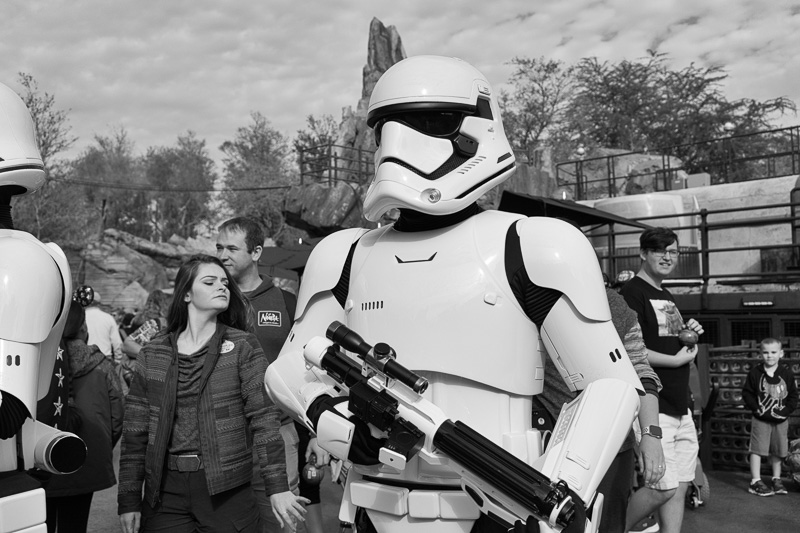
From the parking lot, we caught a shuttle that carted us all of a 100 metres to the entrance. On the way, our shuttle driver reminded us that firearms are not permitted in the park, not even toy guns. We submitted our bags to a thorough search and passed through a metal detector, calling to mind the security measures we encountered at the airport before we flew down. Once the security personnel determined that we weren’t packing—not even toy guns—we went to the ticket booth and each paid US $109 for admission. In 1971, when the Magic Kingdom first opened, the admission price was US $3.50. We presented our tickets at the gate and had our finger prints scanned.
Once inside, we stood in a long line for an amazing morning beverage called Starbucks coffee. While I waited for the Disney/Starbucks workers to make my wife’s super latte fragilistic whatever, I approached an important-looking person holding a clipboard and asked where one might enjoy a sit-down dinner with a glass of wine. She said there were a couple restaurants that might suit me, but the best thing was to download the Disney app and use it to make my reservation. I did as she suggested but couldn’t register. When I switched my country from US to Canada, the field for Zip Code switched to Postal Code, a required field, but there was nothing I could do to put my cursor in the field. My wife downloaded the app and encountered the same glitch. It wasn’t just me.
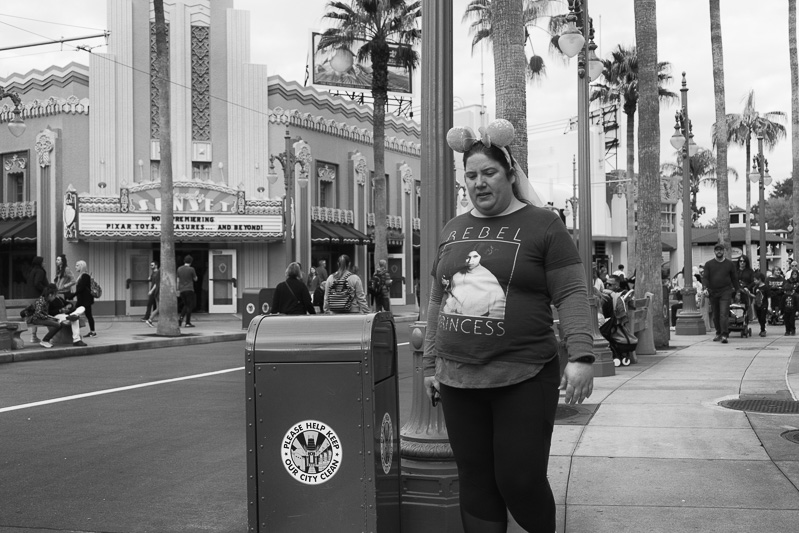
We gave up on the idea of reserving a table at a sit down restaurant and went, instead, to the main attraction which turns out not to be at the galaxy’s edge but at the far side of the park. There, a girl who couldn’t have been more than 20 told us we needed to book our spot in advance using the Disney app. We explained that their app didn’t work. She apologized and said it didn’t matter anyway because they were booked solid for the whole day and there was no way we’d get in. At another attraction, a member of the cast (they are actors, not workers) told us it was booked well into the next month.
We got onto one ride—a Millennium Falcon simulation ride where we served as engineers and had to push a lot of flashing buttons while our ship snatched up some contraband and returned it to our shady boss. After that, there wasn’t much left to do except wander through our futuristic environment and feel the vibe. Like any good street photographer on Mos Eisley, I pretended I was invisible and shot candids of the locals. Every now and then, Kylo Ren made an appearance accompanied by two stormtroopers. Notwithstanding the park’s ban on guns—even toy guns—the stormtroopers carried blasters and swaggered, stiff-torsoed, like they were US Marines.
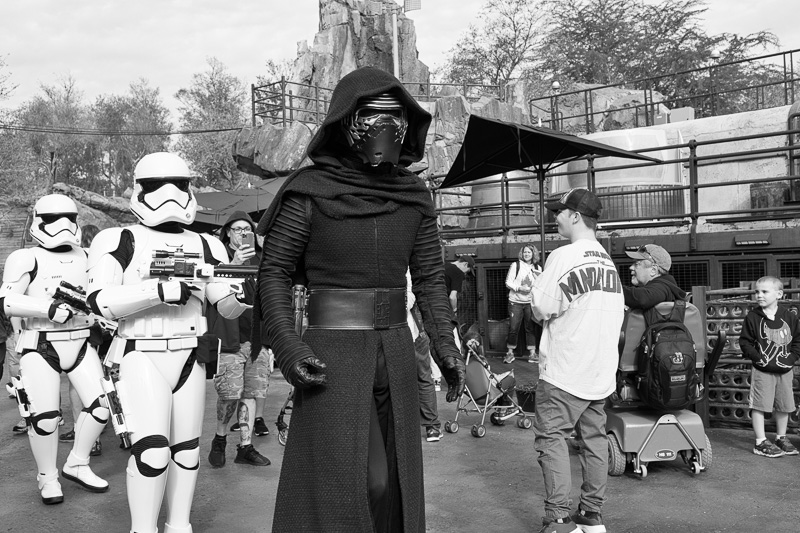
Elsewhere, operatives in local dress checked ID bracelets. Stray stormtroopers accosted guests, making sure they weren’t part of the Resistance. One of those Nazi-looking generals of the Republic, with the hollow cheeks that make him look like he has a futuristic eating disorder, stopped a girl and drew a crowd around her and mock-shamed her as he asked pointed questions about her comings and goings. But it was all in good fun. Just joking, as they say.
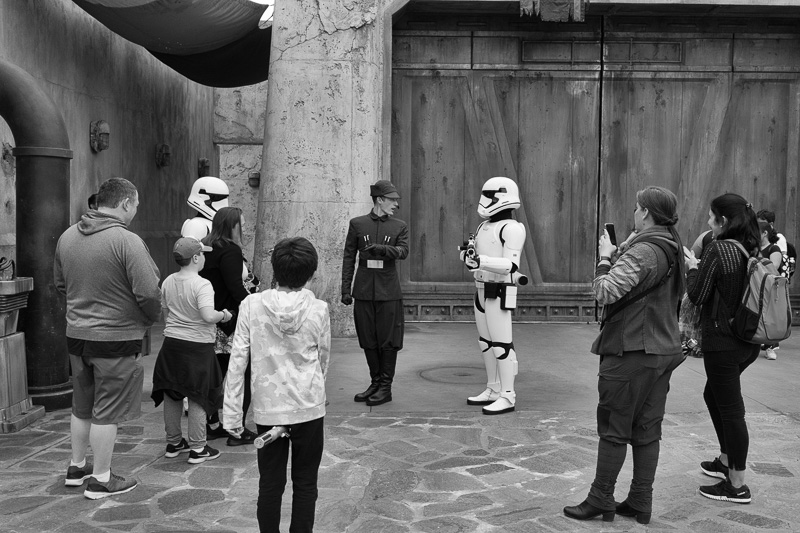
A strange thing happened at the Galaxy’s Edge. Normally, I think of a theme park as a place where you can leave your cares behind. You check them—and maybe your brains, too—at the gate and escape for a day in the pleasure of an alternative experience. But at the Galaxy’s Edge, we see a blurring of the boundaries between the world of our everyday lives, which heaps one source of anxiety on the next, and the theme park world which we hope will offer a respite from that anxiety. Outside, we face anti-abortionist ideologues and gun advocates, security screenings and biometric surveillance, and an executive branch no longer worried about accountability. Inside, for our amusement, we flirt with parallel social arrangements.

Sometimes, my wife says, I’m too cynical; I should relax and enjoy the experience. She assumes the best of people. There’s nothing nefarious going on here, certainly nothing that would distinguish our age from any other. I’m grateful for her positive attitude and hope she is right.
When we fly home from our vacation, I load all my images into Adobe Lightroom and begin the culling/editing process. One photo stands out, not because it’s a great photo but because it captures an unexpected gesture. I took the shot just inside the entrance to the park as I was waiting for my wife to get her super latte fragilistic whatever. “Street performers” had just packed up and were driving away. One, dressed as a 1950’s beat cop, was leaning out the window of his little Mayberry truck and yukking it up with the onlookers. As he passed, I shot a burst of images. I didn’t notice it at the time, but at home, with the luxury of time to more closely examine the images, I saw that the 1950’s beat cop had made the OK sign to somebody standing near me in the crowd. My wife says it’s nothing. With my more cynical bent, I’m not so sure.
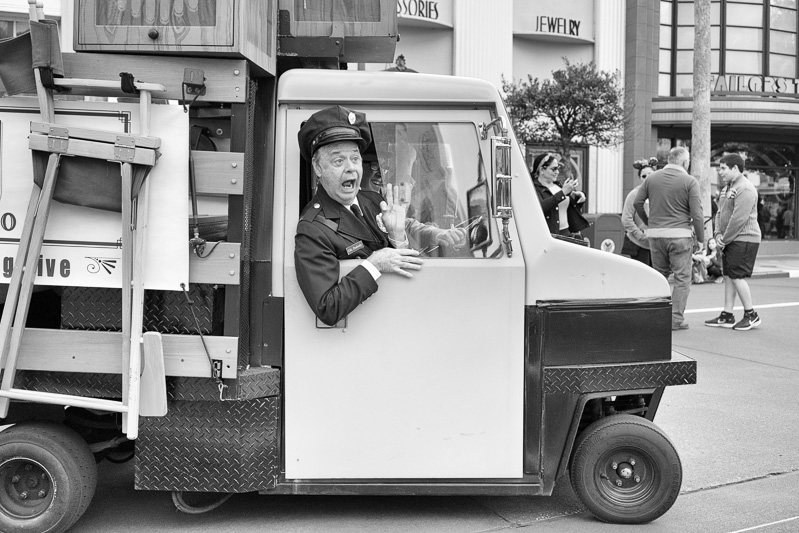
Thanks to a 4Chan hoax, the OK sign has acquired a new layer of meaning. Trolls said the OK sign could also be read as WP—white power—and was being used like a secret handshake between white supremacists adding, in a passive aggressive maneuver worthy of the alt right, that they were just kidding. However, white supremacists have taken it up as their own and are using it without irony in exactly the way the hoaxers said they were. As articles (like the one prepared by the Anti-Defamation League remind us: “The overwhelming usage of the “okay” hand gesture today is still its traditional purpose as a gesture signifying assent or approval.” So I must presume benign intent. The beat cop is just joking around with the guests. And when Kylo Ren orders me to step aside, it’s all in good fun.
Even so, Disney’s Hollywood Studios hasn’t done what it’s supposed to do. There is no escapism here, only a reworked version of the world outside its walls. This is not the park I am looking for.